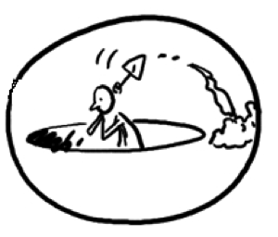 If a gardener sows some flower seeds for you they may blossom briefly, but unless the soil is fertile they will die back and there may be nothing at all to see in a couple of years. Sales training, like flower seeds, needs fertile soil.
If a gardener sows some flower seeds for you they may blossom briefly, but unless the soil is fertile they will die back and there may be nothing at all to see in a couple of years. Sales training, like flower seeds, needs fertile soil.
The Great Train(ing) Robbery
Firstly, who says there is a problem? Well, here are some statistics from the Harvard Business Review. Apparently US companies alone spend an estimated $356 billion on training around the world each year. But most of it fails to make any significant long-term difference. In fact 3 out of 4 senior managers say that the learning and development function is not critical to achieving business outcomes.
If you have just been on a training course this may not sound like your experience. I am confident most participants leave full of enthusiasm and committed to changing the way they work. But if you look back after a year, how satisfied are you then with adoption and the impact on results?
Fortunately, many of our clients are sensitive to this problem and expect us to create fertile soil before doing sales training.
How to create fertile soil
This requires work and commitment from sales management and of course the program participants. The first thing is that salespeople need to be self-critical. Many are overconfident and blame anything but themselves when things go wrong. These are the people who have often been doing things the same way for years. And when circumstances change – they don’t.
The first example of this is a supplier of maintenance services to the mining industry. After many boom years when demand was high the salesforce has had to adapt to a shrinking market with fierce competition. Salespeople have had to switch gear and some simply don’t see the need for personal change.
The second example is a Swiss private bank. For many years Swiss banks kept their client’s banking details secret, which was a big plus for attracting new assets. But recently this secrecy was lifted due to pressure from foreign governments. Swiss banks no longer have this unique competitive advantage, so relationship managers have to work much smarter to retain clients and win new ones.
Changes seem to come increasingly quickly and a salesforce needs to have the right mind-set for training to succeed. More about how to achieve that later.
Top down, bottom up and management systems
It is not just individual salespeople who have to evolve; the whole organisation has to. This means creating a culture of self-reflection - the opposite of a blame culture. People have to be actively encouraged to examine how they are working and think about ways they could improve.
Senior managers have to be both engaged and willing to facilitate change and good coaching skills are essential. But the best results are achieved when the ideas come from the bottom. This is exactly what we did with an enterprise software client recently. We ran design workshops with groups of salespeople and the pre-sales teams they collaborate with to develop a programme of change and they went on to present the results to senior management and get their buy-in.
But the sales excellence program would not have worked without the systems and technology being in place before the training was started. It’s essential that participants should be able to start working in the new way straight away.
Another thing to think about is just how much people can take in in one go. It’s better to introduce a few concepts in a relatively short session then give people time to start implementing them and getting them right before going on to the next set of concepts. So you build the new way of working gradually and don’t overwhelm people. The management system, training materials and technology should combine to help people learn new ideas, put them into practice straight away and go back to remind themselves of specific elements of the training. For the software client I mentioned above we have a mobile app people can use any time to refresh their knowledge and become more proficient.
Practical steps
So we know now why good training can lead to poor results – infertile soil. So here are a few practical steps you can take to put fertile soil in place:
Success Profiles
I have mentioned this concept in my book and iBook Customerized Selling, but in brief, you create an ideal profile of skills for both salespeople and sales managers and ask people to match their own skill level to the Success Profile. It is then clear where each individual has scope for improvement. These profiles are very useful to encourage self-reflection and can be used for recruitment as well.
Management systems & technology
Make sure you have adapted your sales management system before the trainings commence. A good example would be to implement Opportunity Pit-Stops straight after a complex sales training.
Likewise, the technology has to be in place and in particular you need to be sure what you are training people to do works with your CRM system.
Real-life examples
The software and private bank clients I mentioned above tasked a team of ambassadors to review the content and create examples of the new concepts which they went on to present in the training.
Deployment model
Think about how the training will be delivered and by who. Do it all at once and people are likely to forget things or wait too long before they try them. It’s best to deliver the training in chunks so people can get to grips with some concepts before they start on the next. I have found it useful to introduce a way of working in one country and iron out any problems before rolling it out to other countries.
And should you use external consultants like Infoteam to deliver the training? Not necessarily. It might be better if sales leaders learn to deliver it and this develops their own coaching skills.
Refreshment
Self-service refreshers, ideally nuggets of learning that participants can access on their smart phone, are the best way to continuously improve. This also helps to keep behaviour consistent rather than letting people use a version of what they remember from the original training session.
Accreditation
If participants know from the outset that sales leaders and salespeople will be accredited as part of the training they are more motivated to use the best behaviours consistently. And of course it is very positive to give people clear recognition of the improvements they have achieved.
Ask yourself
-
Have you seen the benefits of training diminish rapidly over time?
-
Would you like to get a better return on your investment in training?
-
Are you prepared to do the work to create fertile soil?
Enjoyed this blogpost? Download our eBook:

